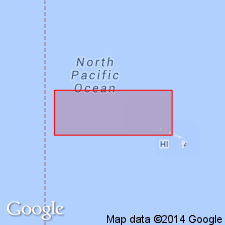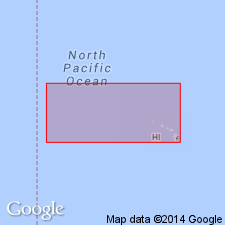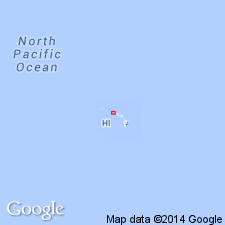
- Usage in publication:
-
- Makalapa tuff*
- Modifications:
-
- Named
- Dominant lithology:
-
- Tuff
- AAPG geologic province:
-
- Oahu
Summary:
Named for Makalapa Crater, E of Pearl Harbor [Puuloa 7.5' quad] Island of Oahu. Included as unit in middle part of Honolulu volcanic series. Not differentiated in field from Salt Lake tuff --which see. Subaerial gray tuff, about 300 ft thick (indistinguishable from Salt Lake tuff). Overlies Aliamanu tuff and Fort Shafter gravels. Assigned to Waipio stand of sea. Assigned to middle(?) and late Pleistocene age.
Source: GNU records (USGS DDS-6; Menlo GNULEX).

- Usage in publication:
-
- Makalapa tuff*
- Modifications:
-
- Age modified
- AAPG geologic province:
-
- Oahu
Summary:
Not separated in mapping from Salt Lake tuff. Same fossils as in Salt Lake tuff (which see). Assigned Pleistocene age
Source: GNU records (USGS DDS-6; Menlo GNULEX).

- Usage in publication:
-
- Makalapa tuff*
- AAPG geologic province:
-
- Oahu
Summary:
Garnet-bearing peridotite xenoliths have been found in Salt Lake, Aliamanu, and Makalapa Tuffs, nepheline-rich members of Honolulu Volcanic Series. Data insufficient at present as to whether any or all of xenoliths are fragments of oceanic mantle.
Source: GNU records (USGS DDS-6; Menlo GNULEX).

- Usage in publication:
-
- Makalapa Tuff†
- Modifications:
-
- Abandoned
- AAPG geologic province:
-
- Oahu
Summary:
Makalapa Tuff (Stearns, IN Stearns and Vaksvik, 1935) abandoned as formally named unit and called Makalapa tuff cone, informal unit in Honolulu Volcanics.
Source: GNU records (USGS DDS-6; Menlo GNULEX).
For more information, please contact Nancy Stamm, Geologic Names Committee Secretary.
Asterisk (*) indicates published by U.S. Geological Survey authors.
"No current usage" (†) implies that a name has been abandoned or has fallen into disuse. Former usage and, if known, replacement name given in parentheses ( ).
Slash (/) indicates name conflicts with nomenclatural guidelines (CSN, 1933; ACSN, 1961, 1970; NACSN, 1983, 2005, 2021). May be explained within brackets ([ ]).

